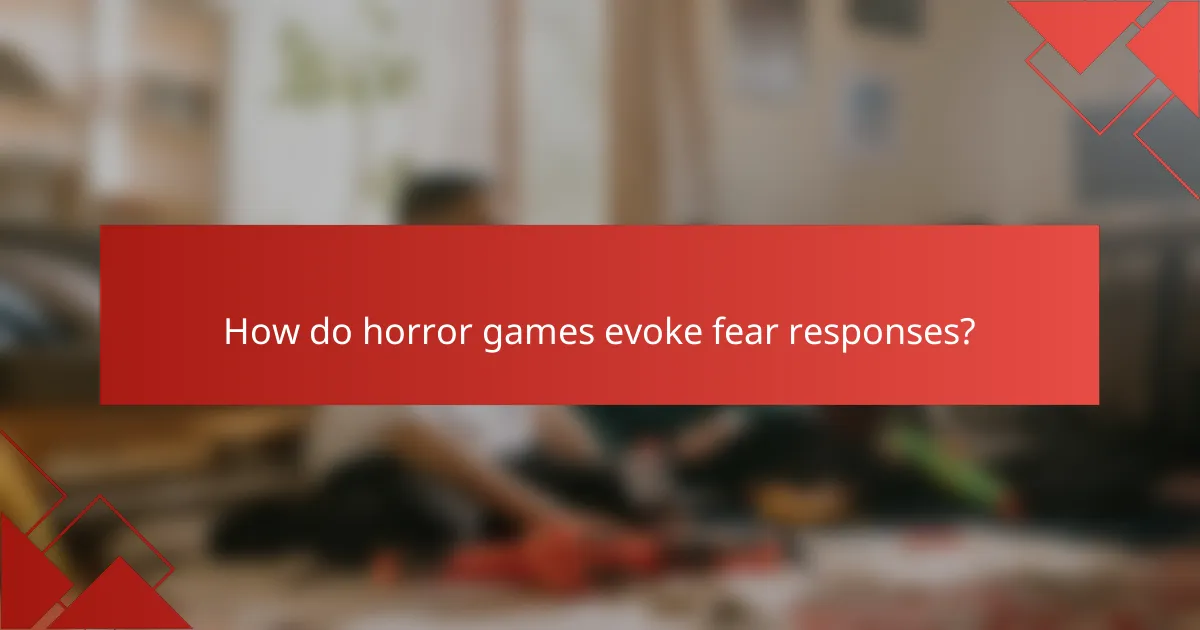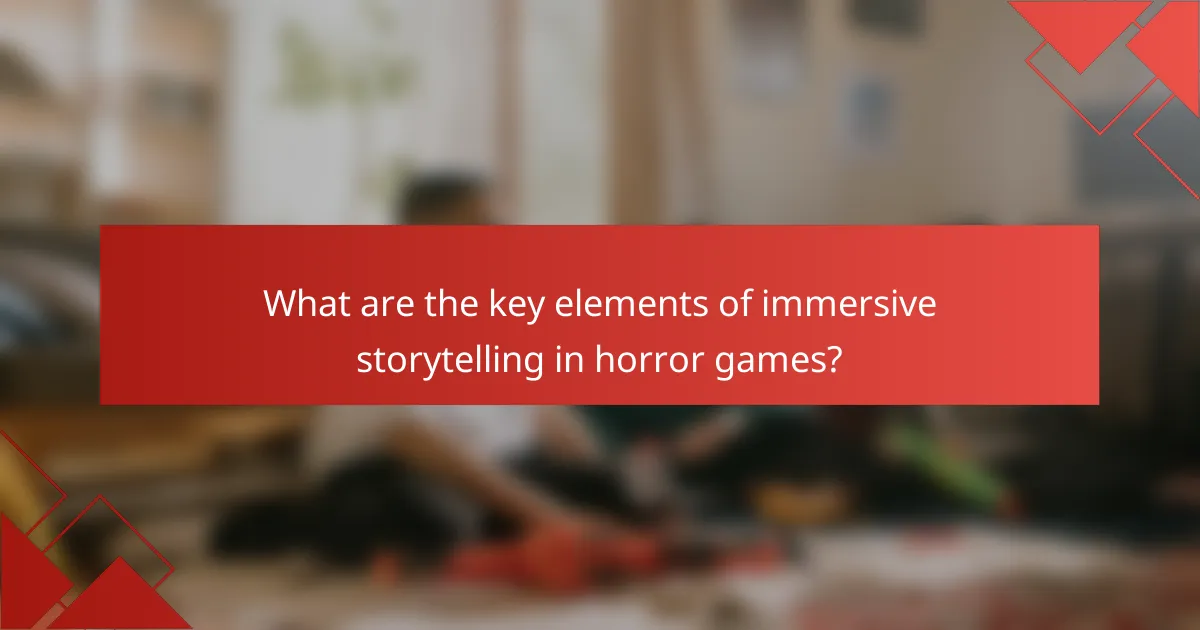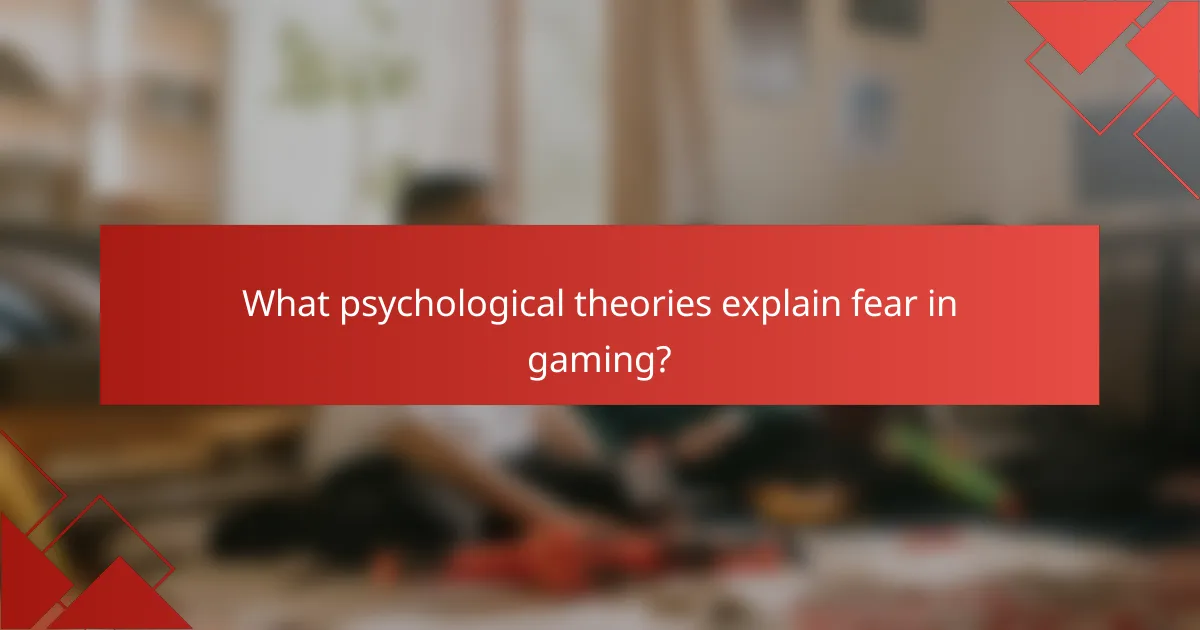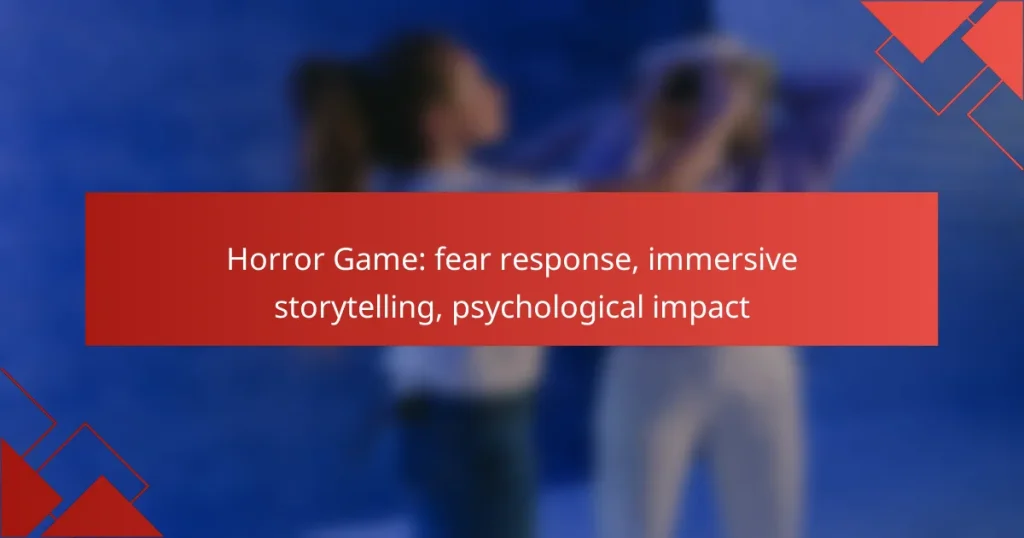Horror games masterfully evoke fear responses by blending psychological techniques with sensory stimuli, crafting an immersive experience that grips players emotionally and cognitively. Through compelling storytelling, character development, and atmospheric design, these games create believable worlds that heighten feelings of dread and anxiety. The psychological impact can vary, influencing players’ well-being and emotional states in profound ways.

How do horror games evoke fear responses?
Horror games evoke fear responses through a combination of psychological techniques and sensory stimuli that create an immersive experience. By engaging players on emotional and cognitive levels, these games can induce feelings of dread, anxiety, and terror.
Use of sound design
Sound design plays a crucial role in eliciting fear in horror games. The use of unsettling sound effects, sudden noises, and eerie music can heighten tension and create a sense of foreboding. For instance, low-frequency sounds can instill a feeling of unease, while abrupt audio cues can trigger instinctive fear responses.
Effective sound design often includes ambient noises that enhance the atmosphere, such as distant whispers or creaking floorboards. These elements can make players feel as if they are not alone, amplifying their fear and engagement with the game.
Visual horror elements
Visual horror elements are essential for creating a terrifying gaming experience. Dark environments, grotesque imagery, and sudden visual shocks can provoke strong emotional reactions. For example, dim lighting can obscure threats, making players more anxious about what might be lurking in the shadows.
Additionally, the use of disturbing character designs and unsettling animations can leave a lasting impact on players. Games that incorporate realistic graphics often enhance the horror experience, as players can more easily relate to the fear depicted on-screen.
Player immersion techniques
Player immersion techniques are vital for deepening the fear response in horror games. Techniques such as first-person perspectives and interactive storytelling allow players to feel as if they are part of the narrative, increasing their emotional investment. This connection can make frightening moments feel more personal and intense.
Moreover, incorporating decision-making elements can heighten tension, as players must confront their fears and make choices that affect the game’s outcome. This active participation can lead to a more profound psychological impact, making the horror experience more memorable.

What are the key elements of immersive storytelling in horror games?
Immersive storytelling in horror games hinges on creating a believable world that evokes fear and emotional engagement. Key elements include character development, environmental storytelling, and narrative pacing, each contributing to the overall psychological impact on players.
Character development
Character development is crucial for fostering emotional connections between players and the game. Well-crafted characters with distinct personalities, motivations, and backstories enhance the player’s investment in their fate. For example, a protagonist who faces personal demons can resonate deeply, making their struggles more impactful.
To effectively develop characters, consider giving them relatable flaws or fears that mirror the game’s themes. This approach can amplify the horror experience, as players may see parts of themselves in the characters, heightening their emotional responses during tense moments.
Environmental storytelling
Environmental storytelling involves using the game world to convey narrative elements without explicit dialogue or exposition. This can include visual cues, such as eerie settings, unsettling soundscapes, or scattered objects that hint at past events. For instance, a blood-stained room can suggest a violent history, creating an atmosphere of dread.
Designing environments that evoke fear requires attention to detail. Use lighting, color palettes, and spatial layouts to guide players’ emotions. Dark, cramped spaces can induce anxiety, while open areas may create a false sense of security that can be shattered unexpectedly.
Narrative pacing
Narrative pacing is essential for maintaining tension and engagement throughout the game. A well-paced story alternates between moments of suspense and action, allowing players to catch their breath before the next scare. This balance keeps players on edge and invested in the unfolding narrative.
To achieve effective pacing, consider using techniques such as cliffhangers, timed events, or gradual reveals of information. Avoid overwhelming players with constant action; instead, allow for quieter moments that build anticipation. This strategy can make the eventual scares more impactful and memorable.

How do horror games impact psychological well-being?
Horror games can significantly influence psychological well-being by eliciting fear responses and creating immersive experiences. These games often engage players emotionally, which can lead to both positive and negative psychological effects depending on the individual’s mindset and context of play.
Short-term effects of fear
In the short term, horror games can trigger intense fear responses, leading to heightened adrenaline levels and increased heart rates. Players may experience a rush of excitement and thrill, which can be enjoyable for many. However, this fear can also result in anxiety or stress, especially for those who are more sensitive to horror elements.
Common short-term effects include temporary feelings of unease, jump scares, and a sense of urgency while navigating the game. Players often report feeling a mix of fear and exhilaration, which can enhance the overall gaming experience.
Long-term psychological implications
Over time, repeated exposure to horror games may lead to desensitization, where players become less responsive to fear stimuli. This can alter their perception of fear in real life, potentially diminishing their ability to react appropriately to genuine threats. Some players may develop a tolerance for horror, seeking out increasingly intense experiences to achieve the same thrill.
Conversely, for some individuals, prolonged engagement with horror games can exacerbate anxiety or lead to nightmares. It’s essential for players to monitor their emotional responses and take breaks if they notice negative effects on their mental health.
Therapeutic uses of horror games
Horror games can also serve therapeutic purposes, particularly in controlled environments. They can help individuals confront their fears in a safe setting, allowing for gradual exposure to anxiety-inducing scenarios. This method can be beneficial for those dealing with specific phobias or anxiety disorders.
Some therapists incorporate horror games into treatment plans, using them as tools for discussion and reflection. Players can explore their reactions to fear and anxiety, facilitating deeper understanding and coping strategies. However, it is crucial that this approach is guided by a professional to ensure safety and effectiveness.

What are the best horror games for immersive experiences in the UK?
The best horror games for immersive experiences in the UK include titles that effectively combine fear response, storytelling, and psychological impact. These games engage players through atmospheric environments, compelling narratives, and intense gameplay mechanics that evoke strong emotional reactions.
Resident Evil Village
Resident Evil Village offers a rich blend of horror and action, set in a visually stunning environment that enhances immersion. Players navigate a mysterious village filled with grotesque creatures and intricate puzzles, all while uncovering a gripping story that keeps them on edge.
The game’s first-person perspective intensifies the fear factor, making players feel vulnerable and engaged. With a mix of exploration, combat, and resource management, it challenges players to think strategically while maintaining a constant sense of dread.
Silent Hill 2
Silent Hill 2 is renowned for its psychological horror elements and deep narrative, which explores themes of guilt and trauma. The fog-laden town of Silent Hill serves as a haunting backdrop, filled with unsettling creatures and eerie sound design that amplifies the atmosphere.
This game emphasizes storytelling through environmental clues and character interactions, encouraging players to piece together the protagonist’s troubled past. Its slow-paced gameplay allows for a gradual build-up of tension, making each encounter feel impactful and memorable.
Amnesia: The Dark Descent
Amnesia: The Dark Descent is a cornerstone of psychological horror, focusing on atmosphere and player vulnerability. The game employs a first-person perspective that immerses players in a dark, foreboding castle filled with terrifying creatures and mind-bending puzzles.
One of its key features is the sanity meter, which decreases in darkness or when witnessing horrifying events, adding a layer of strategy to gameplay. Players must manage their resources and navigate the environment carefully, as every decision can lead to a heightened sense of fear and anxiety.

How do horror games utilize player agency?
Horror games leverage player agency by allowing choices that significantly impact gameplay and narrative. This engagement fosters a deeper emotional connection, enhancing the fear response and overall immersion.
Choices affecting outcomes
In horror games, player choices can lead to drastically different outcomes, influencing both the story and character fates. For instance, deciding whether to save a character or explore a dangerous area can lead to survival or demise, amplifying tension and fear.
These choices often create moral dilemmas, forcing players to weigh their options carefully. This dynamic not only heightens suspense but also encourages players to replay the game to explore alternative paths.
Interactive environments
Interactive environments in horror games enhance immersion by allowing players to manipulate objects and navigate spaces that react to their actions. For example, opening a creaky door or hiding behind furniture can create a sense of vulnerability and tension.
These environments often contain hidden clues or threats, encouraging exploration and engagement. Players must remain vigilant, as seemingly innocuous actions can lead to unexpected scares or discoveries.
Multiple endings
Many horror games feature multiple endings based on player choices, which adds replayability and depth to the narrative. These endings can range from tragic to hopeful, depending on the decisions made throughout the game.
Players are motivated to revisit the game to uncover all possible outcomes, enhancing their emotional investment. This structure not only reinforces the impact of player agency but also allows for a personalized horror experience.

What psychological theories explain fear in gaming?
Several psychological theories help explain the fear response in gaming, focusing on how players engage with immersive storytelling and the emotional impact of gameplay. Understanding these theories can enhance the design of horror games, making them more effective in eliciting fear and tension.
Fight or flight response
The fight or flight response is a physiological reaction that occurs when a player perceives a threat in a game. This instinctual response triggers adrenaline release, heightening awareness and preparing the body for action. In horror games, this can manifest as increased heart rate and heightened senses, making players feel more engaged and anxious.
Designers can leverage this response by creating scenarios that evoke real fear, such as unexpected jump scares or relentless pursuers. Balancing moments of tension with brief respites can enhance the overall experience, keeping players on edge without overwhelming them.
Suspension of disbelief
Suspension of disbelief refers to the willingness of players to accept the fictional elements of a game as reality, allowing them to engage emotionally with the narrative. In horror games, this is crucial for experiencing fear; players must immerse themselves in the story and accept the game world as plausible.
To foster this suspension, developers should create relatable characters and believable settings. High-quality graphics, sound design, and coherent storytelling can enhance this effect, making players more susceptible to fear-inducing elements.
Immersion theory
Immersion theory posits that the deeper a player is immersed in a game, the more intense their emotional responses will be, including fear. This immersion can be achieved through engaging narratives, realistic environments, and interactive gameplay mechanics that draw players into the experience.
To maximize immersion, game developers should focus on creating a cohesive atmosphere that aligns visuals, sound, and gameplay. Techniques such as environmental storytelling and player agency can significantly enhance the feeling of being part of the game world, amplifying the psychological impact of fear.


